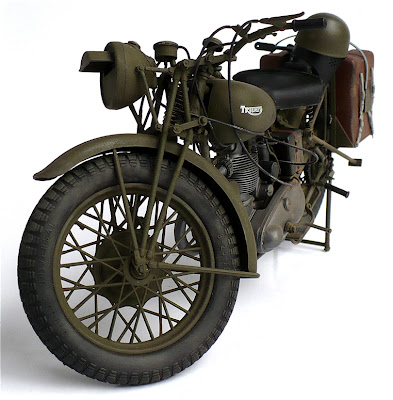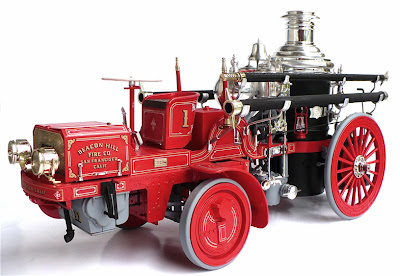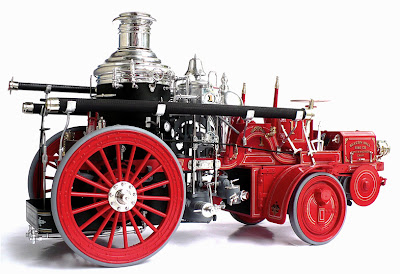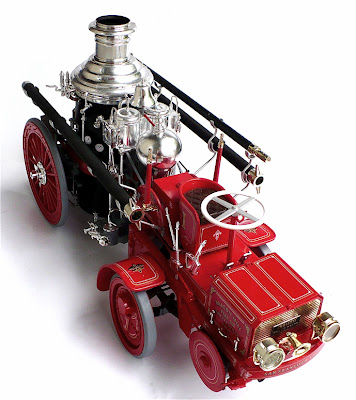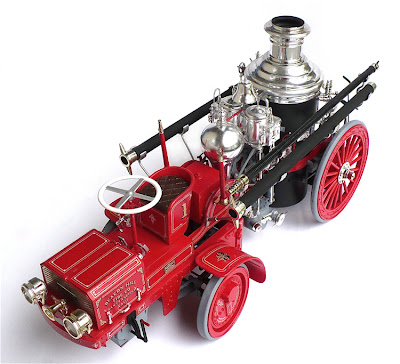Translate
Wednesday, July 31, 2013
Triumph Tiger 80/3HW Motorcycle
Here are some more images of Aurora/ESCI's 1/9 scale Triumph Tiger 80/3HW Motorcycle. From Wikipedia. "The Triumph Tiger 80 was a British motorcycle first made by Triumph from 1937. There was also a 250cc Tiger 70 and a 500cc Tiger 90. Production of the Tiger ended with the outbreak of WW2 and never resumed after the Triumph works at Priory Street in Coventry were completely destroyed". "When World War 2 broke out in 1939, the Tiger was developed into the military Triumph 3HW model. The Triumph works was destroyed by German bombers on the night of the 14th November 1940 - along with much of the city of Coventry bringing production of the Tiger 80 to an end. When Triumph recovered and began production again at Meriden,only the Tiger 100 survived in the new production line".
Monday, July 29, 2013
Zundapp KS-750 Motorcycle With BMW Sidecar
Here are some images of Aurora/ESCI's 1/9 scale Zundapp KS-750
motorcycle with BMW sidecar. The Zundapp was the most advanced
motorcycle of its day. The Zundapp was a very rugged and versatile
motorcycle. The shaft drive setup that was powered by a 751cc engine
proved to be very dependable with good acceleration with an overdrive
giving it a top speed of 60 mph. Along with the BMW 750 the Zundapps
rugged reliability was to make it a common sight on all fronts during
the war. One of the things that made the Zundapp unique was it's
winterizing gear. This was a heating system for the hands and toes which
drew heat from the exhaust system which I'm sure was greatly
appreciated by its riders especially on the Russian front.
Saturday, July 27, 2013
Zundapp KS 750 "Elephant"
Here are some more images of Aurora/ ESCI 1/9 scale Zundapp KS 750 "Elephant" Motorcycle.
From Wikipedia"
Zündapp (aka Zuendapp) was a major German motorcycle manufacturer. The company was founded in 1917 in Nuremberg by Fritz Neumeyer, together with the Friedrich Krupp AG and the machine tool manufacturer Thiel under the name "Zünder- und Apparatebau G.m.b.H." as a producer of detonators. In 1919, as the demand for weapons parts declined after the First World War, Neumeyer became the sole proprietor of the company, and two years later he diversified into the construction of motorcycles. The company folded in 1984.
The first Zündapp motorcycle was the model Z22 in 1921. This was the Motorrad für Jedermann
("motorcycle for everyone"), a simple and reliable design that was
produced in large series. Zündapp's history of heavy motorcycles began
in 1933 with the K-series. The "K" stands for "Kardanantrieb", i.e.
enclosed driveshaft with two universal joints, the type of drivetrain
that these models used. They introduced the enclosed engine case, a
novelty at the time. The series encompassed models from 200 to 800 cc displacement and was a major success, increasing Zündapp's market share in Germany from 5% in 1931 to 18% in 1937.
From 1931 Ferdinand Porsche and Zündapp developed the prototype Auto für Jedermann ("car for everyone"), which was the first time the name "Volkswagen"
was used. Porsche preferred the 4-cylinder flat engine, but Zündapp
used a water-cooled 5-cylinder radial engine. In 1932 three prototypes
were running. All three cars were lost during the war, the last in 1945
in Stuttgart during a bombing raid.
From
1936 to 1938 Zündapp produced the KKS500 model. This was the first
Zündapp with a foot gearchange, and 170 examples were built. From 1940 onwards Zündapp produced more than 18,000 units of the Zündapp KS 750. This is a sidecar outfit with a driven side wheel and a locking differential, supplied to the German Wehrmacht.
After the Second World War the company gradually shifted to producing smaller machines, notably the "Bella" motor scooter,
which was, however, a relatively heavy machine for its type. In 1951
Zündapp released the last of its heavy motorcycle models, but also one
of its most famous: the KS601 (the "green elephant") with a 598 cc two
cylinder engine. From 1957 to 1958 the company also produced the Zündapp Janus microcar.
In 1958 the company moved from Nuremberg to Munich. Subsequently, the company developed several new smaller models, discontinued the development of four-stroke engines and only produced two-stroke models. Initially, Zündapp scooters and mopeds sold well, but later sales declined and in 1984 the company went bankrupt and closed.
After the bankruptcy, the entire production line and intellectual properties was bought by Xunda Motor Co., Tianjin,
China. They produced small Zündapp motorcycles from 1987 till early
1990s. Zundapp is still in business, but makes Honda based 4-stroke
motorcycles and electric mopeds. [
Zündapp also had a technical collaboration with Enfield India to build mopeds and motorcycles. A dedicated factory was built at Ranipet near Chennai in early 1980’s to manufacture small, lightweight two stroke motorcycles to be offered along with their flagship Royal Enfield Bullet. Enfield launched two 50cc motorcycles first,the step- thru Silver Plus
and the 3-speed Explorer motorcycle. Later, 175cc Enfield Fury (based
on Zündapp KS175) was introduced as a performance motorcycle. It had
5-speed gearbox, a hydraulic Brembo disc brake and a sleeveless hard chromed cylinder barrel, all were a first on a motorcycle in that country.
Thursday, July 25, 2013
Alien Tripod From War Of The Worlds
This kit gives you the option of building this model in the laser arms configuration or the collecting cages and tentacles option (pictured).
The one thing one should be aware of is that this kit is made of ABS plastic so your standard model glue won't be as strong. I would recommend CA glue.
However this is one beautiful and cool model kit.
From Wikipedia"
War of the Worlds is a 2005 American science fiction film adaptation of H. G. Wells' novel of the same name, directed by Steven Spielberg and written by Josh Friedman and David Koepp. It is one of three film adaptations of War of the Worlds released that year, alongside The Asylum's version and Pendragon Pictures' version. It stars Tom Cruise
as Ray Ferrier, a divorced dock worker estranged from his children and
living separately from them. As his ex-wife drops their children off
for him to look after for a few days, Earth is invaded by aliens
(loosely based on H. G. Wells' Martians) driving Tripods and the earth's armies are defeated, and Ray tries to protect his children and flee to Boston to rejoin his ex-wife.
War of the Worlds marks Spielberg and Cruise's second collaboration, after the 2002 film Minority Report. The film was shot in 73 days, using five different sound stages as well as locations at Connecticut, Staten Island, California, Virginia, and New Jersey.
The film was surrounded by a secrecy campaign so few details would be
leaked before its release. Tie-in promotions were made with several
companies, including Hitachi. The film was released in United States on 29 June and in United Kingdom
on 1 July. The film generally received positive reviews, and attained a
73 percent "fresh" rating on the film review aggregator Rotten Tomatoes, based on 240 reviews. War of the Worlds
was also a box office success, and was 2005's fourth most successful
film both domestically, with $234 million in North America, and
worldwide, with $591 million overall.
Industrial Light & Magic was the main special effects company for the movie. While Spielberg had used computers to help visualize sequences in pre-production before, Spielberg said, "This is the first film I really tackled using the computer to animate all the storyboards." He decided to employ the technique extensively after a visit to his friend George Lucas. In order to keep the realism, the usage of computer-generated imagery shots and bluescreen
was limited, with most of the digital effects being blended with
miniature and live-action footage. The design of the Tripods was
described by Spielberg as "graceful," with artist Doug Chiang
replicating aquatic lifeforms. The visual effects crew tried to blend
organic and mechanical elements in the Tripods depiction, and made
extensive studies for the movements of the vehicle to be believable,
considering the "contradiction" of having a large tank-like head being
carried by thin and flexible legs.
Visual effects supervisor Pablo Helman considered depicting the scale
of the Tripod as challenging, considering "Steven wanted to make sure
that these creatures were 150 feet tall". The aliens themselves had designs based on jellyfish, with movements inspired by red-eyed tree frogs.
Spielberg did not want any blood or gore during the Heat-Ray deaths;
in the words of Helma, "this was going to be a horror movie for kids".
So the effects crew came up with the vaporization of the bodies, and
considering it could not be fully digital due to both the complexity of
the effect and the schedule, live-action dust was used alongside the
CGI ray assimilation and particles.
McDonnell Douglas F-4j Phantom II
I dare say that this is the best F-4 phantom kit out there today.
From Wikipedia"
The McDonnell Douglas F-4 Phantom II is a tandem (two-seat), twin-engined, all-weather, long-range supersonic jet interceptor fighter/fighter-bomber originally developed for the United States Navy by McDonnell Aircraft. It first entered service in 1960 with the U.S. Navy. Proving highly adaptable, it was also adopted by the U.S. Marine Corps and the U.S. Air Force, and by the mid-1960s had become a major part of their respective air wings.
The Phantom is a large fighter with a top speed of over Mach 2.2. It can carry over 18,000 pounds (8,400 kg) of weapons on nine external hardpoints,
including air-to-air and air-to-ground missiles, and various bombs.
The F-4, like other interceptors of its time, was designed without an
internal cannon, but later models incorporated a M61 Vulcan rotary cannon. Beginning in 1959, it set 15 world records, including an absolute speed record, and an absolute altitude record.
The F-4 was used extensively during the Vietnam War,
serving as the principal air superiority fighter for both the Navy and
Air Force, as well as being important in the ground-attack and reconnaissance roles by the close of U.S. involvement in the war. The Phantom has the distinction of being the last U.S. fighter flown to attain ace status in the 20th century. During the Vietnam War, the USAF had one pilot and two weapon systems officers (WSOs),
and the US Navy one pilot and one radar intercept officer (RIO),
achieve five aerial kills against other enemy fighter aircraft and
become aces in air-to-air combat.
The F-4 continued to form a major part of U.S. military air power
throughout the 1970s and 1980s, being gradually replaced by more modern
aircraft such as the F-15 Eagle and F-16 in the U.S. Air Force; the Grumman F-14 Tomcat and F/A-18 Hornet in the U.S. Navy; and the F/A-18 in the U.S. Marine Corps.
The F-4 Phantom II remained in use by the U.S. in the reconnaissance and Wild Weasel (suppression of enemy air defenses) roles in the 1991 Gulf War, finally leaving service in 1996. It was also the only aircraft used by both U.S. flight demonstration teams: the USAF Thunderbirds (F-4E) and the US Navy Blue Angels (F-4J). The F-4 was also operated by the armed forces of 11 other nations. Israeli Phantoms saw extensive combat in several Arab–Israeli conflicts, while Iran used its large fleet of Phantoms in the Iran–Iraq War. Phantoms remain in front line service with seven countries, and in use as an unmanned target in the U.S. Air Force.
Phantom production ran from 1958 to 1981, with a total of 5,195 built,
making it the most numerous American supersonic military aircraft.
On 30 December 1960, the VF-121 "Pacemakers" at NAS Miramar became the first Phantom operator with its F4H-1Fs (F-4As). The VF-74 "Be-devilers" at NAS Oceana became the first deployable Phantom squadron when it received its F4H-1s (F-4Bs) on 8 July 1961.
The squadron completed carrier qualifications in October 1961 and
Phantom’s first full carrier deployment between August 1962 and March
1963 aboard USS Forrestal. The second deployable U.S. Atlantic Fleet squadron to receive F-4Bs was the VF-102 "Diamondbacks", who promptly took their new aircraft on the shakedown cruise of USS Enterprise. The first deployable U.S. Pacific Fleet squadron to receive the F-4B was the VF-114 "Aardvarks", which participated in the September 1962 cruise aboard USS Kitty Hawk.
By the time of the Tonkin Gulf incident, 13 of 31 deployable Navy squadrons were armed with the type. F-4Bs from USS Constellation made the first Phantom combat sortie of the Vietnam War on 5 August 1964, flying bomber escort in Operation Pierce Arrow. The first Phantom air-to-air victory of the war took place on 9 April 1965 when an F-4B from VF-96 "Fighting Falcons" piloted by Lieutenant (junior grade) Terence M. Murphy and his RIO, Ensign Ronald Fegan, shot down a Chinese MiG-17 "Fresco". The Phantom was then shot down, apparently by an AIM-7 Sparrow from one of its wingmen.There
continues to be controversy over whether the Phantom was shot down by
MiG guns or whether, as enemy reports later indicated, an AIM-7 Sparrow
III from one of Murphy's and Fegan's wingmen. On 17 June 1965, an F-4B from VF-21 "Freelancers" piloted by Commander Louis Page and Lieutenant John C. Smith shot down the first North Vietnamese MiG of the war.
On 10 May 1972, Lieutenant Randy "Duke" Cunningham and Lieutenant (junior grade) William P. Driscoll flying an F-4J, call sign "Showtime 100", shot down three MiG-17s to become the first American flying aces of the war. Their fifth victory was believed at the time to be over a mysterious North Vietnamese ace, Colonel Nguyen Toon, now considered mythical. On the return flight, the Phantom was damaged by an enemy surface-to-air missile.
To avoid being captured, Cunningham and Driscoll flew their burning
aircraft using only the rudder and afterburner (the damage to the
aircraft rendered conventional control nearly impossible), until they
could eject over water.
During
the war, U.S. Navy F-4 Phantom squadrons participated in 84 combat
tours with F-4Bs, F-4Js, and F-4Ns. The Navy claimed 40 air-to-air
victories at a cost of 73 Phantoms lost in combat (seven to enemy
aircraft, 13 to SAMs, and 53 to AAA). An additional 54 Phantoms were lost in mishaps.
By
1983, the F-4Ns had been completely replaced by F-14 Tomcats, and by
1986 the last F-4Ss were exchanged for F/A-18 Hornets. On 25 March
1986, an F-4S belonging to the VF-151 "Vigilantes," became the last active duty U.S. Navy Phantom to launch from an aircraft carrier, in this case, the USS Midway. On 18 October 1986, an F-4S from the VF-202 "Superheats", a Naval Reserve fighter squadron, made the last-ever Phantom carrier landing while operating aboard USS America.
In 1987, the last of the Naval Reserve-operated F-4S aircraft were
replaced by F-14As. The last Phantoms in service with the Navy were QF-4
target drones operated by the Naval Air Warfare Centers at NAS Point Mugu, California. These airframes were subsequently retired in 2004.
Wednesday, July 24, 2013
Christie American Steam Fire Engine
Here are some more images of MPC/AMT 1/12 scale Christie American steam fire engine.
From The instructions"
The Christie steam pumper was the backbone of America's fire fighting organizations prior to World War One. It was unique in that it was gas engine driven and it also employed front wheel drive. The unit served in most of the cities across the United States during the early 1900's.
The Christie was actually a modernization of the old turn of the century horse drawn steam pumpers. Walter Christie, a famed race car designer, and "Father of Front Wheel Drive Technology" designed a gas driven tractor to pull the old steam pumpers and thereby extend their useful lives. His tractor design worked so well that colorful old steam pumpers were used until well into the gasoline era.
http://www.youtube.com/watch?v=ylfwzi4Sikk&feature=youtu.be
From The instructions"
The Christie steam pumper was the backbone of America's fire fighting organizations prior to World War One. It was unique in that it was gas engine driven and it also employed front wheel drive. The unit served in most of the cities across the United States during the early 1900's.
The Christie was actually a modernization of the old turn of the century horse drawn steam pumpers. Walter Christie, a famed race car designer, and "Father of Front Wheel Drive Technology" designed a gas driven tractor to pull the old steam pumpers and thereby extend their useful lives. His tractor design worked so well that colorful old steam pumpers were used until well into the gasoline era.
http://www.youtube.com/watch?v=ylfwzi4Sikk&feature=youtu.be
McDonnell Douglas F/A - 18 D Hornet
From Wikipedia"
The McDonnell Douglas (now Boeing) F/A-18 Hornet is a twin-engine supersonic, all-weather carrier-capable multirole fighter jet, designed to dogfight and attack ground targets (F/A for Fighter/Attack). Designed by McDonnell Douglas and Northrop, the F/A-18 was derived from the latter's YF-17 in the 1970s for use by the United States Navy and Marine Corps.
The Hornet is also used by the air forces of several other nations. It
has been the aerial demonstration aircraft for the U.S. Navy's Flight
Demonstration Squadron, the Blue Angels, since 1986.
The F/A-18 has a top speed of Mach 1.8. It can carry a wide variety of bombs and missiles, including air-to-air and air-to-ground, supplemented by the 20 mm M61 Vulcan cannon. It is powered by two General Electric F404 turbofan engines, which give the aircraft a high thrust-to-weight ratio. The F/A-18 has excellent aerodynamic characteristics, primarily attributed to its leading edge extensions (LEX). The fighter's primary missions are fighter escort, fleet air defense, Suppression of Enemy Air Defenses (SEAD), air interdiction, close air support and aerial reconnaissance.
Its versatility and reliability have proven it to be a valuable
carrier asset, though it has been criticized for its lack of range and
payload compared to its earlier contemporaries, such as the Grumman F-14 Tomcat in the fighter and strike fighter role, and the Grumman A-6 Intruder and LTV A-7 Corsair II in the attack role.
The F/A-18 Hornet provided the baseline design for the Boeing F/A-18E/F Super Hornet,
a larger, evolutionary redesign of the F/A-18. Compared to the Hornet,
the Super Hornet is larger, heavier and has improved range and
payload. The F/A-18E/F was originally proposed as an alternative to an
all-new aircraft to replace existing dedicated attack aircraft such as
the A-6. The larger variant was also directed to replace the aging F-14
Tomcat, thus serving a complementary role with Hornets in the U.S.
Navy, and serving a wider range of roles including refueling tanker.
The Boeing EA-18G Growler electronic jamming platform was also developed from the F/A-18E/F Super Hornet.
The F/A-18C is the single-seat variant and the F/A-18D
is the two-seat variant. The D-model can be configured for training or
as an all-weather strike craft. The "missionized" D model's rear seat
is configured for a Marine Corps Naval Flight Officer
who functions as a Weapons and Sensors Officer to assist in operating
the weapons systems. The F/A-18D is primarily operated by the U.S.
Marine Corps in the night attack and FAC(A) (Forward Air Controller (Airborne)) roles.
The F/A-18C and D models are the result of a block upgrade in 1987 incorporating upgraded radar, avionics, and the capacity to carry new missiles such as the AIM-120 AMRAAM air-to-air missile and AGM-65 Maverick and AGM-84 Harpoon air-to-surface missiles. Other upgrades include the Martin-Baker NACES (Navy Aircrew Common Ejection Seat), and a self-protection jammer. A synthetic aperture ground mapping radar
enables the pilot to locate targets in poor visibility conditions. C
and D models delivered since 1989 also have improved night attack
abilities, consisting of the Hughes AN/AAR-50 thermal navigation pod, the Loral AN/AAS-38 NITE Hawk FLIR (forward looking infrared array) targeting pod, night vision goggles, and two full-color (formerly monochrome) multi-function display (MFDs) and a color moving map.
In addition, 60 D-model Hornets are configured as the night attack F/A-18D (RC) with ability for reconnaissance. These could be outfitted with the ATARS electro-optical sensor package that includes a sensor pod and equipment mounted in the place of the M61 cannon.
Beginning
in 1992, the F404-GE-402 enhanced performance engine, providing
approximately 10% more maximum static thrust became the standard Hornet
engine.
Since 1993, the AAS-38A NITE Hawk added a designator/ranger laser,
allowing it to self-mark targets. The later AAS-38B added the ability to
strike targets designated by lasers from other aircraft.
Production of the F/A-18C ended in 1999. In 2000, the last F/A-18D was delivered to the U.S. Marine Corps.
Tuesday, July 23, 2013
de Havilland Mosquito NF Mk. II Night Fighter 2
Here are some more images of Revell/Paragon 1/32 scale de Havilland Mosquito NF MkII Night Fighter.
From Wikipedia"
The first production night fighter Mosquitos were designated NF Mk II. A total of 466 were built with the first entering service with No. 157 Squadron in January 1942, replacing the Douglas Havoc. These aircraft were similar to the F Mk II, but were fitted with the AI Mk IV metric wavelength radar. The herring-bone transmitting antenna was mounted on the nose and the dipole receiving antennae were carried under the outer wings.
A number of NF IIs had their radar equipment removed and additional
fuel tanks installed in the bay behind the cannon for use as night
intruders. These aircraft, designated NF II (Special) were first used by 23 Squadron in operations over Europe in 1942. 23 Squadron was then deployed to Malta on 20 December 1942, and operated against targets in Italy.
Ninety-seven NF Mk IIs were upgraded with centimetric AI Mk VIII radar and these were designated NF Mk XII. The NF Mk XIII,
of which 270 were built, was the production equivalent of the Mk XII
conversions. The centimetric radar sets were mounted in a solid
"thimble" (Mk XII / XIII) or universal "bull nose" (Mk XVII / XIX)
radome, which required the machine guns to be dispensed with.
Il Volo Instrumentale Da Vinci's Flying Machine
Here are some more images of Incunabula Museum series il volo instrumentale
Da Vinci's Flying Machine. In its configuration Da Vinci's Flying
Machine would not have flown however I think that if one were to flip
the wing spars up 90 degrees and if one were to get rid of that
flapping wing idea it just might fly.
From Da Vinci Inventions"
Of Leonardo da Vinci’s many areas of study, perhaps this Renaissance man’s favorite was the area of aviation. Da Vinci seemed truly excited by the possibility of people soaring through the skies like birds.
One of da Vinci’s most famous inventions, the flying machine (also known as the "ornithopter") ideally displays his powers of observation and imagination, as well as his enthusiasm for the potential of flight. The design for this invention is clearly inspired by the flight of winged animals, which da Vinci hoped to replicate. In fact, in his notes, he mentions bats, kites and birds as sources of inspiration.
Perhaps the inspiration of the bat shines through the most, as the two wings of the device feature pointed ends commonly associated with the winged creature. Leonardo da Vinci’s flying machine had a wingspan that exceeded 33 feet, and the frame was to be made of pine covered in raw silk to create a light but sturdy membrane.
The pilot would lie face down in the center of the invention on a board. To power the wings, the pilot would pedal a crank connected to a rod-and-pulley system. The machine also had a hand crank for increased energy output, and a head piece for steering. As the busy pilot spins cranks with his hands and feet, the wings of the machine flap. The inspiration of nature in the invention is apparent in the way the wings were designed to twist as they flapped.
Unfortunately, as da Vinci himself might have realized, while the flying machine may have flown once it was in the air, a person could never have created enough power to get the device off the ground.
From Da Vinci Inventions"
Of Leonardo da Vinci’s many areas of study, perhaps this Renaissance man’s favorite was the area of aviation. Da Vinci seemed truly excited by the possibility of people soaring through the skies like birds.
One of da Vinci’s most famous inventions, the flying machine (also known as the "ornithopter") ideally displays his powers of observation and imagination, as well as his enthusiasm for the potential of flight. The design for this invention is clearly inspired by the flight of winged animals, which da Vinci hoped to replicate. In fact, in his notes, he mentions bats, kites and birds as sources of inspiration.
Perhaps the inspiration of the bat shines through the most, as the two wings of the device feature pointed ends commonly associated with the winged creature. Leonardo da Vinci’s flying machine had a wingspan that exceeded 33 feet, and the frame was to be made of pine covered in raw silk to create a light but sturdy membrane.
The pilot would lie face down in the center of the invention on a board. To power the wings, the pilot would pedal a crank connected to a rod-and-pulley system. The machine also had a hand crank for increased energy output, and a head piece for steering. As the busy pilot spins cranks with his hands and feet, the wings of the machine flap. The inspiration of nature in the invention is apparent in the way the wings were designed to twist as they flapped.
Unfortunately, as da Vinci himself might have realized, while the flying machine may have flown once it was in the air, a person could never have created enough power to get the device off the ground.
Subscribe to:
Posts (Atom)

